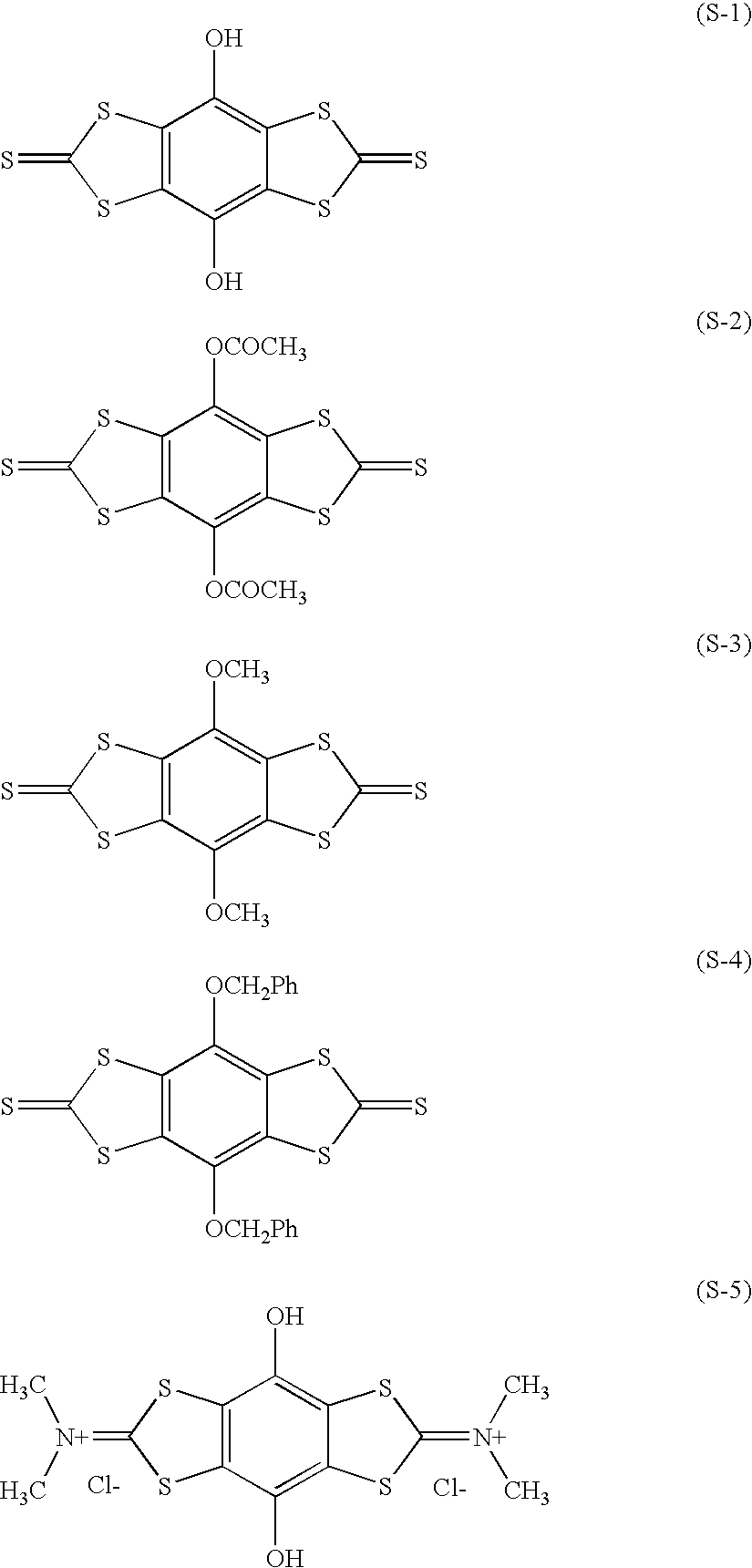Heterocyclic compound, ultraviolet absorbent and composition containing the same
a heterocyclic compound and ultraviolet absorbent technology, applied in the field of new heterocyclic compound, ultraviolet absorbent and composition, can solve the problems of limited freedom in selecting the compound, new compounds have not been found, and the structure is limited to a narrow scope, so as to improve the molar extinction coefficient and excellent ultraviolet absorbing performance.
- Summary
- Abstract
- Description
- Claims
- Application Information
AI Technical Summary
Benefits of technology
Problems solved by technology
Method used
Image
Examples
example 1
Preparation of Exemplified Compound (1)
[0342]To a solution of 80 g of sodium hydroxide dissolved in 800 ml of ethanol, 100 mL of ethanol solution of 66 g of malononitrile was added while cooling with ice, and subsequently 76 g of carbon disulfide was added. After reaction at room temperature for 1 hour, the obtained solid was filtrated and then washed with ethanol, to give 166 g of the following synthetic intermediate A (yield: 89%).
[0343]To a dispersion of 12.3 g of chloranil dispersed in 100 mL of N,N-dimethylacetamide, 50 ml of solution of the following synthetic intermediate A was added while cooling with ice, and allowed to react at room temperature for 6 hours. After adding water to the reaction solution, the obtained solid was filtrated and then washed with water, to give 15 g of the following synthetic intermediate B (yield: 78%).
[0344]To a dispersion of 1.16 g of the synthetic intermediate B in 5 mL of N,N-dimethylacetamide, 0.84 mL of 2,6-lutidine was added, and subsequent...
example 2
Preparation of Exemplified Compound (2)
[0359]To a dispersion of 1.16 g of the synthesis intermediate B above in 5 mL of N,N-dimethylacetamide, 1.24 mL of 2-ethylhexylbromide was added, and subsequently 1 g of potassium carbonate was added and allowed to react at 60° C. for 5 hours. Water was added to the reaction solution, and the obtained solid was filtrated, washed with water and purified, to give 0.5 g of the exemplified compound (2) (yield: 27%).
[0360]MS: m / z 610 (M+)
[0361]λmax=381 nm (EtOAc), ε=78000
example 3
Preparation of Exemplified Compound (72)
[0362]To a solution of 22.4 g of potassium hydroxide dissolved in 250 mL of ethanol, 21.3 mL of ethyl cyanoacetate was added while cooling with ice, and subsequently 15.2 g of carbon disulfide was added, and allowed to react at room temperature for 1 hour. The obtained solid was filtrated, washed with ethanol, to give 36.5 g of the synthetic intermediate C above (yield: 69%).
[0363]To a dispersion of 6.1. g of chloranil dispersed in 50 mL of N,N-dimethylacetamide, 25 ml of solution of the synthetic intermediate C above was added while cooling with ice, and allowed to react at room temperature for 5 hours. Water was added to the reaction solution, the obtained solid was filtrated and then washed with water, to give 15 g of the exemplified compound (72) (yield: 78%).
[0364]MS: m / z 480 (M+)
[0365]The exemplified compound (72) could also be prepared by the following preparation method.
[0366]N-methylpyrrolidone was added to a mixture of the synthetic ...
PUM
 Login to View More
Login to View More Abstract
Description
Claims
Application Information
 Login to View More
Login to View More - R&D
- Intellectual Property
- Life Sciences
- Materials
- Tech Scout
- Unparalleled Data Quality
- Higher Quality Content
- 60% Fewer Hallucinations
Browse by: Latest US Patents, China's latest patents, Technical Efficacy Thesaurus, Application Domain, Technology Topic, Popular Technical Reports.
© 2025 PatSnap. All rights reserved.Legal|Privacy policy|Modern Slavery Act Transparency Statement|Sitemap|About US| Contact US: help@patsnap.com



